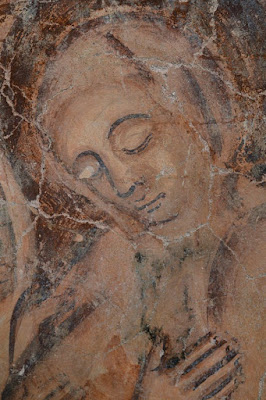 |
| Press conference with Ernő Marosi, József Lángi and Zsombor Jékely (photo: Magyar Kurír) |
The medieval wall paintings of the church were preserved in the sanctuary. Their existence had been known for some time, and their presence under later layers of plaster was established in 2001. Several details had been uncovered by restorer József Lángi in 2012, which led to a plan for their complete recovery. Once the community of the church was also convinced of the importance of these frescoes, work could commence with the help of the Rómer Flóris Plan. In September – October 2019, the entire surface of the sanctuary wall has been cleaned and wall paintings have been uncovered on the northern and southern wall of the sanctuary, as well as around the eastern windows.
 |
| Passion cycle on the northern wall of the sanctuary |
The ensemble recovered by József Lángi is fragmentary: a large Late Gothic window opened in the southern wall destroyed a large portion of the wall paintings. The vaults collapsed (most likely in 1717) and were replaced by a flat ceiling – thus a very important part of the former ensemble is missing. A 19th-century gallery installed in the sanctuary for an organ caused further damage. Despite all this, a remarkably complete cycle of wall paintings has come to light. The northern and southern wall of the sanctuary was decorated with a detailed Christological cycle, narrating the story of Christ from the Annunciation through the Passion all the way to the death and Coronation of the Virgin Mary.
 |
| Massacre of the Innocents |
The surface of the wall paintings still needs to be cleaned and they need to be restored – a task which can hopefully be completed during the next two years. In the meantime, we can already establish that the fresco cycle was painted during the second part of the reign of King Sigismund (1387-1437) – most likely in the 1420s. No other works are known by the same workshop in the Upper Tisza Valley, so the discovery of these frescoes is a significant addition to our knowledge about medieval painting in north-eastern Hungary. Art historical research on the fresco cycle will commence in the near future, and hopefully, initial results will be published soon.
You can read more about the press conference (in Hungarian) in this overview by Magyar Kurír. To learn more about the medieval churches of the region, have a look at the website of the Route of Medieval Churches. Photos in the post are by Attila Mudrák.







:strip_icc()/BHG_PTSN19720-33d9cd22f6ab49e6a21982e451321898.jpg)

More Stories
Mapping Eastern Europe Website Launched
Kengo Kuma Designs a Dramatically Vaulted Cafe to Evoke Japan’s Sloping Tottori Sand Dunes — Colossal
Keeping The Artist Alive | Chris Locke | Episode 888